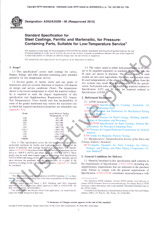We need your consent to use the individual data so that you can see information about your interests, among other things. Click "OK" to give your consent.
ASTM D8393-21
Standard Guide for Determination of Pore Volume of Powdered Catalysts and Catalyst Carriers by Water Adsorption
Translate name
STANDARD published on 1.6.2021
The information about the standard:
Designation standards: ASTM D8393-21
Publication date standards: 1.6.2021
SKU: NS-1031758
The number of pages: 4
Approximate weight : 12 g (0.03 lbs)
Country: American technical standard
Category: Technical standards ASTM
Annotation of standard text ASTM D8393-21 :
Keywords:
catalytic material, FCC, fluid catalytic cracking catalyst, pore volume, water adsorption,
Additional information
| Significance and Use |
|
5.1?This guide is intended to determine meso- and macropore volume which affects heavy oil cracking performance of a catalyst. The information is useful for materials specification, manufacturing control, and research and development in the evaluation of catalytic materials. 5.2?It has been reported in literature the existence of a correlation between the pore volume obtained from this guide and that from Test Method D4284.3 |
| 1. Scope |
|
1.1?This guide measures pore volume of powdered catalysts and catalyst carriers by titration with water. The water does not react with material. The range of pore volume is 0.25 mL/g to 0.46 mL/g. 1.2?This guide is suitable for fine catalysts such as fluid catalytic cracking (FCC) catalysts (fresh or equilibrium), catalyst additives and spray dried catalyst carriers or finished catalysts, or a combination thereof, and is typically applicable to powders with the majority of particles (above 90 %) in the distribution range between 20 and 150 ?m equivalent spherical diameter (determined by Test Method D4464) and with an average particle size between 60 and 100 ?m. Note 1:?This technique is capable of measuring particles below
and above this range (for example, from 1 to 300 ?m) but no
precision data is available.
1.3?UnitsThe values stated in SI units are to be regarded as standard. No other units of measurement are included in this standard. 1.4?This standard does not purport to address all of the safety concerns, if any, associated with its use. It is the responsibility of the user of this standard to establish appropriate safety, health, and environmental practices and determine the applicability of regulatory limitations prior to use. 1.5?This international standard was developed in accordance with internationally recognized principles on standardization established in the Decision on Principles for the Development of International Standards, Guides and Recommendations issued by the World Trade Organization Technical Barriers to Trade (TBT) Committee. |
We recommend:
Technical standards updating
Do you want to make sure you use only the valid technical standards?
We can offer you a solution which will provide you a monthly overview concerning the updating of standards which you use.
Would you like to know more? Look at this page.




 Cookies
Cookies
